Contents
One of the almost forgotten Soviet breeds, bred in the southern region of the USSR, the Kotlyarevskaya breed of chickens, is increasingly beginning to interest the owners of private farmsteads. The breed was bred in the Caucasus, at the Kotlyarevsky breeding farm, which gave its name to the new chickens of the meat and egg direction.
Kotlyarevsky chickens were bred by crossing five breeds:
- neck;
- New Hampshire;
- Zagorsk salmon;
- white;
- cuckoo plymouth.
Thanks to this cocktail, the coloring of kotlyarevsky chickens is very variable. The offspring are still splitting by color.
Further selection with a new breed was carried out in the direction of increasing egg productivity. Today, according to the owners, Kotlyarevsky chickens are more of an egg type than meat.
Description of Kotlyarevsky chickens with a photo

The general impression of the bird: a slender, elegant body of the egg direction. The head is small, with a single leaf-shaped crest. The teeth should stand out well on the comb, especially the middle ones. The face, earrings and lobes are red. Lobes are allowed combined: white with red. The eyes are orange-red. The neck is of medium length, set high, with a graceful curve at the top. The mane of a rooster is medium in size.
The hull is solidly built. Placed horizontally. The back and loin are long, straight and wide. The shoulders are wide, the wings are tightly pressed to the body. The tail of the rooster is set horizontally, triangular in shape. Pigtails are relatively short. The chest is wide, convex, well filled. Legs of medium length, with non-feathered metatarsus. The color of the pluses is yellow.
Any colors characteristic of the original breeds are allowed: salmon, cuckoo, silver, fawn, partridge and others.
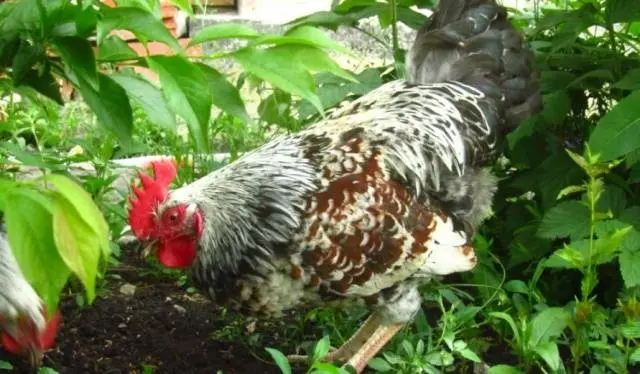
Perhaps this culling is due to the fact that the gene responsible for the brown color of the feathers is linked to the gene responsible for the production of testosterone in roosters. There is a known case when a “brown” rooster attacked everything that moves. At the same time, his fellow from the same herd, but without brown feathers, behaved calmly.
In this case, the genes responsible for the color are always linked to the genes that provoke diseases.
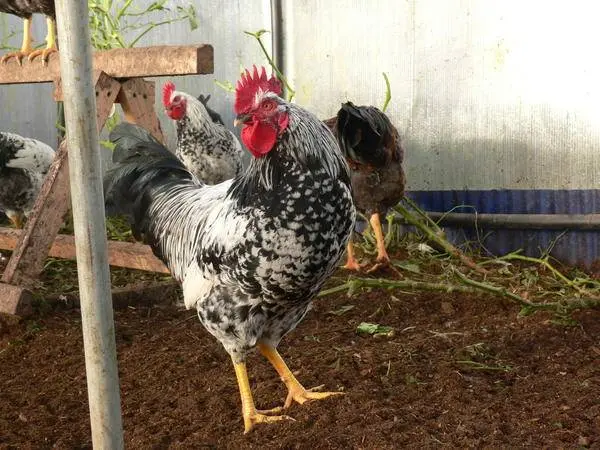
Correct rooster color. And also one of the options for the correct color for chickens of the Kotlyarevsky breed in the photo below.
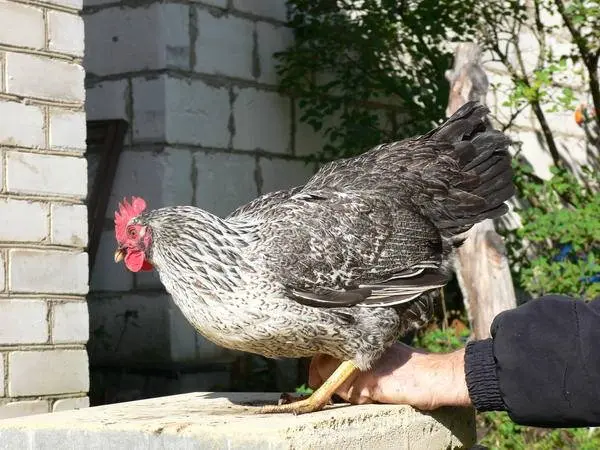
Productive characteristics
The description of the Kotlyarevskaya breed of chickens indicates that they are precocious and rather heavy birds. The weight of a six-month-old Kotlyarevsky rooster reached 3 kg. An adult rooster reached 3,8 kg. The chicken weighed 2,5 to 3 kg. But it was the old meat and egg type. Perhaps it can still be found in some courtyards.
Today, priorities have shifted towards egg production and the weight of Kotlyarevsky chickens has decreased. The modern description of the Kotlyarevsky chicken indicates that the weight of the laying hen is up to 2300 g, the rooster is up to 2800 g.
But egg productivity has increased significantly. Today, up to 240 eggs can be obtained from a Kotlyarevsky laying hen. During molting, Kotlyarevsky chickens do not stop laying, although productivity decreases somewhat.
In terms of the size of the eggs laid, the Kotlyarevsky chicken is not inferior to industrial egg crosses. The eggs of an adult chicken reach up to 65 g. In the youngest, the very first testicle can weigh about 50 g.
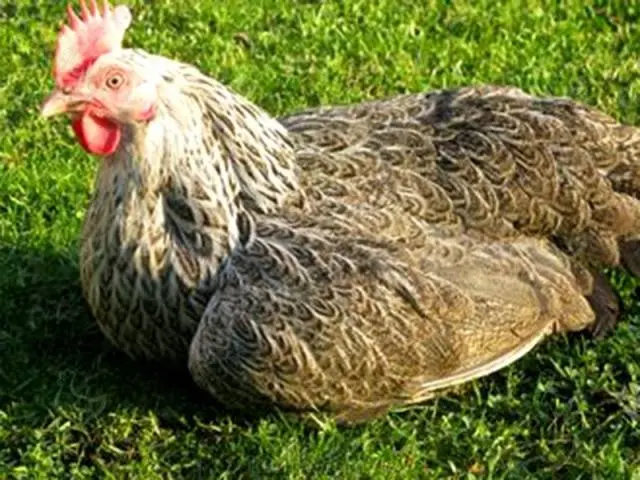
Pros of the breed
Like any Soviet chicken, hardened by socialism, Kotlyarevskaya is unpretentious to the conditions of keeping and feeding. It can be carried regardless of weather conditions. Differs in the long productive period (5 years), meat precocity. And undemanding to feed.
Kotlyarevsky chickens can consume any food, but for high productivity they will have to be fed with good feed, allowing the body of the chicken to get everything it needs to lay eggs.
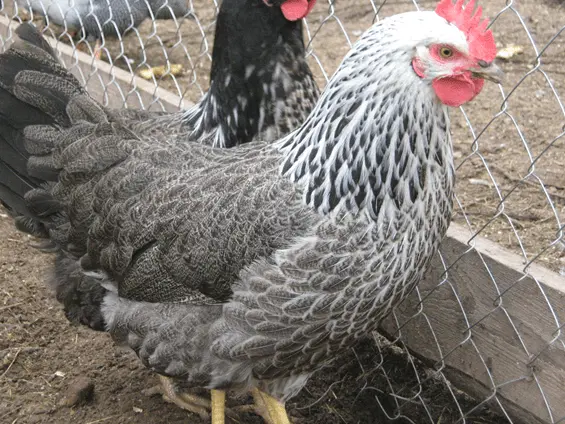
Cons of the breed
Chickens fly well and can visit their neighbors in search of something tasty. It is unlikely that the visit will please the neighbors.
Until now, splitting in the offspring is observed in the breed. Because of this, the productivity of young birds, even from the same clutch, may differ.
The main disadvantage of the breed is its small number. The Kotlyarevskaya breed of chickens has not become widespread and it is very difficult to get it today. Up to the point that residents of the Leningrad region complain about the inability to renew the herd. Although otherwise, they have only positive reviews about the Kotlyarevsky breed of chickens.
Conditions of detention
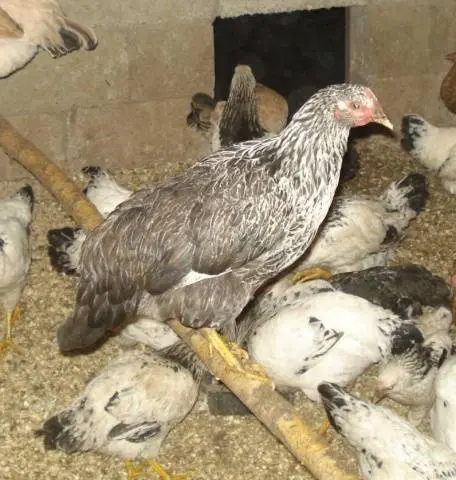
Although these chickens are very unpretentious, it is necessary to provide the minimum conditions for their comfortable existence. The chicken coop may not be heated, especially in the southern region. The main thing is that the birds have a roof over their heads from the rain and enough food in the feeder to generate energy that warms them.
Straw, sawdust or peat must be laid on the floor. For the winter, they make a thick litter, which will slither down and give off heat. In this case, peat is preferable. The top layer must be turned up and sprinkled with fresh bedding.
For spending the night, Kotlyarevsky chickens need to equip perches. The ideal option would be just thick branches from trees, as in the photo above. Somewhat worse, but acceptable – perches made of boards not high above the floor.
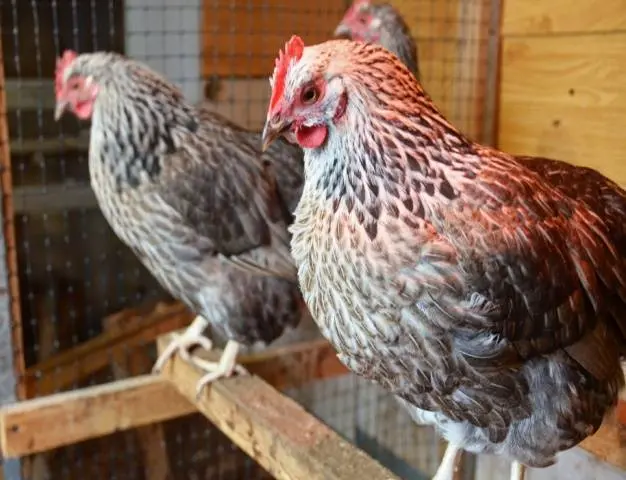
Nest boxes for laying eggs are equipped at the rate of at least 1 box for 5 layers. If there is an opportunity to do more, it is better to do more. Straw or hay is placed in the boxes. It is undesirable to leave them completely empty. This is uncomfortable for the hens and can cause the hen to crush the eggs.

To get eggs in winter, chickens need a long daylight hours. For maximum egg production, they need at least 12 hours.
To protect birds from skin parasites when keeping livestock in winter, sand-ash baths should be placed in the chicken coop, not forgetting to change their contents as often as possible.
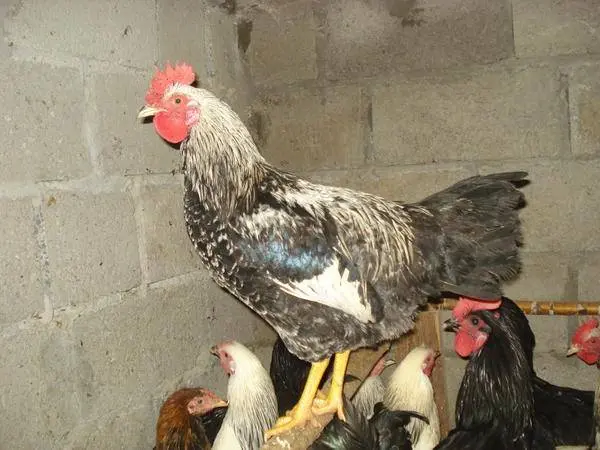
Diet for Kotlyarevsky chickens
The breed has an interesting feature: it can do almost nothing but pasture. But then you should not expect large eggs from her in large quantities. With full feeding, this chicken can carry eggs up to 70 g in weight. Moreover, it responds very quickly to improved nutrition, immediately thanks to the owner.
All the food they eat goes to increase the size of the egg. Roosters from abundant feeding can get fat. Therefore, if a rooster is planned for slaughter in the future and you want to get a fat carcass, it is “planted” on grain feed.
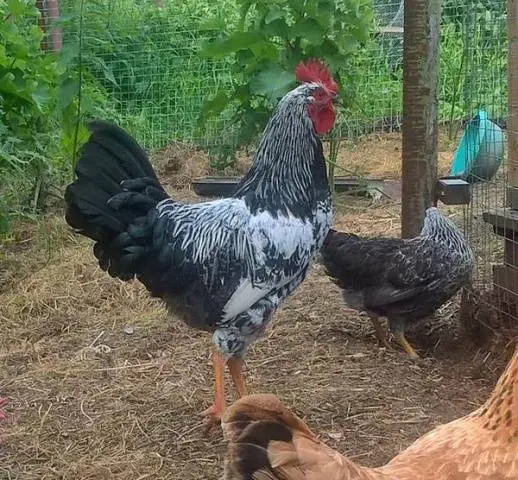
Laying hens are provided not only with grain mixture, but also with greens, vegetables, meat and bone meal, vitamin and mineral premixes. With high-quality balanced nutrition from laying hens, they get the maximum return.
Breeding of the Kotlyarevsky breed of chickens
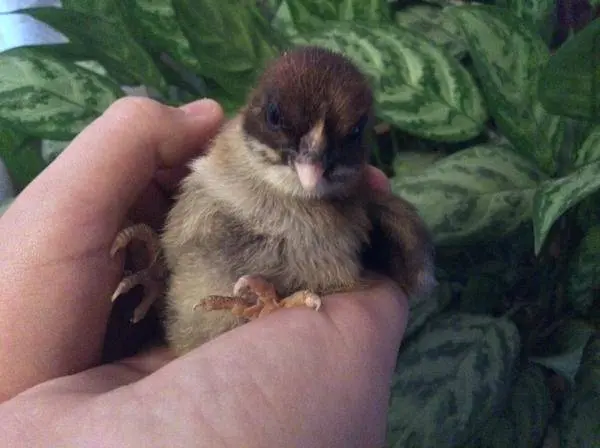
Puberty in Kotlyarevsky pullets usually occurs at 6 months. When fed with industrial compound feeds containing an increased amount of vitamins, maturation can occur at 4 months. But such early production will later adversely affect the laying hen and the quality of her offspring. If the chickens are planned to be left for self-repair, then the puberty of the future laying hen should not be accelerated.
Families are formed at the rate of 7 – 12 hens per rooster. Fertility in Kotlyarevsky chickens is very high. The safety of hatched chicks reaches 95%.
For breeding, it is preferable to use an incubator. The degree of development of the instinct of incubation in the Kotlyarevsky breed is questionable. Given further selection towards egg production, we can conclude that this instinct will fade away.

Later, the young blooms into “pied”. The safety of young birds is 85%.
Reviews from owners of Kotlyarevsky chickens
Conclusion
The Kotlyarevskaya breed of chickens is great for those private traders who can buy it. So far, only the gene pool can guarantee the purchase of purebred Kotlyarevsky chickens, where these chickens are kept for the sake of genetic diversity and as a reserve for breeding other breeds.









